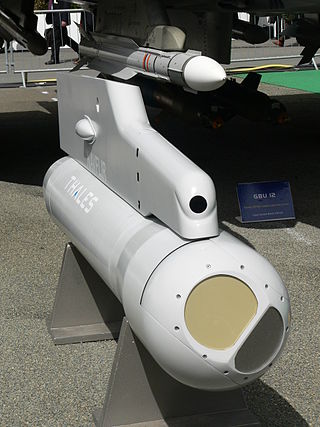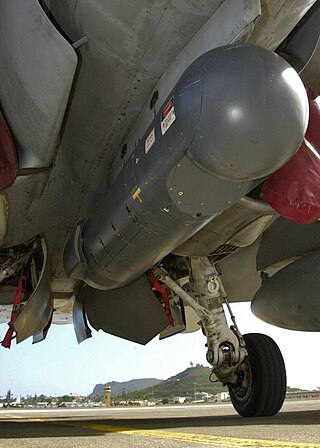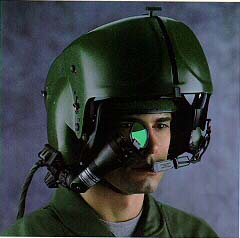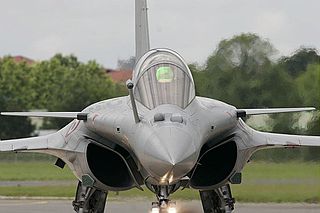
The Eurofighter Typhoon is a European multinational twin-engine, canard delta wing, multirole fighter. The Typhoon was designed originally as an air-superiority fighter and is manufactured by a consortium of Airbus, BAE Systems and Leonardo that conducts the majority of the project through a joint holding company, Eurofighter Jagdflugzeug GmbH. The NATO Eurofighter and Tornado Management Agency, representing the UK, Germany, Italy and Spain, manages the project and is the prime customer.

Forward-looking infrared (FLIR) cameras, typically used on military and civilian aircraft, use a thermographic camera that senses infrared radiation.

Night vision is the ability to see in low-light conditions, either naturally with scotopic vision or through a night-vision device. Night vision requires both sufficient spectral range and sufficient intensity range. Humans have poor night vision compared to many animals such as cats, dogs, foxes and rabbits, in part because the human eye lacks a tapetum lucidum, tissue behind the retina that reflects light back through the retina thus increasing the light available to the photoreceptors.

The fourth-generation fighter is a class of jet fighters in service from around 1980 to the present, and represents design concepts of the 1970s. Fourth-generation designs are heavily influenced by lessons learned from the previous generation of combat aircraft. Third-generation fighters were often designed primarily as interceptors, being built around speed and air-to-air missiles. While exceptionally fast in a straight line, many third-generation fighters severely lacked in maneuverability, as doctrine held that traditional dogfighting would be impossible at supersonic speeds. In practice, air-to-air missiles of the time, despite being responsible for the vast majority of air-to-air victories, were relatively unreliable, and combat would quickly become subsonic and close-range. This would leave third-generation fighters vulnerable and ill-equipped, renewing an interest in manoeuvrability for the fourth generation of fighters. Meanwhile, the growing costs of military aircraft in general and the demonstrated success of aircraft such as the McDonnell Douglas F-4 Phantom II gave rise to the popularity of multirole combat aircraft in parallel with the advances marking the so-called fourth generation.

An air-to-air missile (AAM) is a missile fired from an aircraft for the purpose of destroying another aircraft. AAMs are typically powered by one or more rocket motors, usually solid fueled but sometimes liquid fueled. Ramjet engines, as used on the Meteor, are emerging as propulsion that will enable future medium- to long-range missiles to maintain higher average speed across their engagement envelope.

Stealth aircraft are designed to avoid detection using a variety of technologies that reduce reflection/emission of radar, infrared, visible light, radio frequency (RF) spectrum, and audio, collectively known as stealth technology. The F-117 Nighthawk was the first operational aircraft explicitly designed around stealth technology. Other examples of stealth aircraft include the B-2 Spirit, the B-21 Raider, the F-22 Raptor, the F-35 Lightning II, the Chengdu J-20, and the Sukhoi Su-57.

HOTAS, an acronym of hands on throttle-and-stick, is the concept of placing buttons and switches on the throttle lever and flight control stick in an aircraft cockpit. By adopting such an arrangement, pilots are capable of performing all vital functions as well as flying the aircraft without having to remove their hands from the controls.

The Lockheed Martin Sniper is a targeting pod for military aircraft that provides positive target identification, autonomous tracking, GPS coordinate generation, and precise weapons guidance from extended standoff ranges.

The AN/AAQ-28(V) Litening targeting pod is an advanced precision targeting pod system currently operational with a wide variety of aircraft worldwide. The research and development of the Litening was first undertaken by Rafael Advanced Defense Systems' Missiles Division in Israel, with subsequent completion of Litening I for use in the Israeli Air Force.

An infrared search and track (IRST) system is a method for detecting and tracking objects which give off infrared radiation, such as the infrared signatures of jet aircraft and helicopters.
Thales Optronics is a optronics manufacturer and a division of the French defence corporation Thales Group. It is headquartered in Paris. The company has three main subsidiaries: Thales Optronique SA in France, Thales Optronics Limited in the United Kingdom and Thales Optronics B.V in the Netherlands.
Electro-optical MASINT is a subdiscipline of Measurement and Signature Intelligence, (MASINT) and refers to intelligence gathering activities which bring together disparate elements that do not fit within the definitions of Signals Intelligence (SIGINT), Imagery Intelligence (IMINT), or Human Intelligence (HUMINT).
The Space Tracking and Surveillance System was a pair of satellites developed by the United States Missile Defense Agency (MDA) to research the space-based detection and tracking of ballistic missiles. Data from STSS satellites could allow interceptors to engage incoming missiles earlier in flight than would be possible with other missile detection systems. The STSS program began in 2001, when the "SBIRS Low" program was transferred to MDA from the United States Air Force. In December 2002, SBIRS Low Research & Development was renamed Space Tracking and Surveillance System (STSS).

A helmet-mounted display (HMD) is a headworn device that uses displays and optics to project imagery and/or symbology to the eyes. It provides visual information to the user where head protection is required – most notably in military aircraft. The display-optics assembly can be attached to a helmet or integrated into the design of the helmet. An HMD provides the pilot with situation awareness, an enhanced image of the scene, and in military applications cue weapons systems, to the direction their head is pointing. Applications which allow cuing of weapon systems are referred to as helmet-mounted sight and display (HMSD) or helmet-mounted sights (HMS).

The Optronique Secteur Frontal (OSF) is a long-range optoelectronics system, developed for the French Dassault Rafale combat aircraft.

An enhanced flight vision system is an airborne system which provides an image of the scene and displays it to the pilot, in order to provide an image in which the scene and objects in it can be better detected. In other words, an EFVS is a system which provides the pilot with an image which is better than unaided human vision. An EFVS includes imaging sensors such as a color camera, infrared camera or radar, and typically a display for the pilot, which can be a head-mounted display or head-up display. An EFVS may be combined with a synthetic vision system to create a combined vision system.

The EuroDASS Praetorian DASS is an integral part of Eurofighter Typhoon defensive Aid Sub-System (DASS) providing threat assessment, aircraft protection and support measures in extremely hostile and severe environments. As the DASS is fully integrated, it does not require additional pods that take up weapon stations or would influence the aircraft's aerodynamic performance. In addition the modular nature of the DASS simplifies future upgrades and allows each partner nation or export customer the option to tailor the DASS to their individual needs.
FIAR S.p.A. was an Italian avionics and radar manufacturer; the Eurofighter's current radar contains its technology.

The Sea Oryx is a lightweight, infrared homing short-range air defense system developed for the Republic of China (Taiwan) Navy. Based on the TC-1L surface-to-air missile, it is designed to defend against anti-ship missiles, helicopters, and low flying fixed-wing jet airplanes. It is reported to have strong similarities to the American RIM-116 Rolling Airframe Missile and uses components of the Sky Sword I air-to-air missile.
















